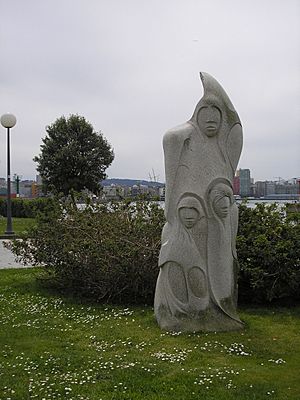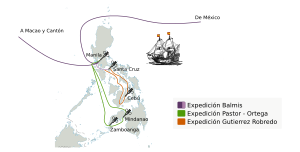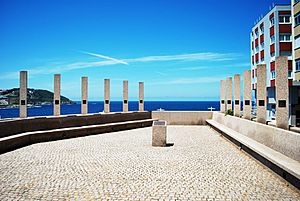Balmis Expedition facts for kids
The Royal Philanthropic Vaccine Expedition (also known as the Balmis Expedition) was a special Spanish health mission. It happened from 1803 to 1806. Dr. Francisco Javier de Balmis led this important journey. The goal was to give millions of people in Spanish America and Asia a vaccine against smallpox. What made it unique was how the vaccine was carried: it traveled through orphaned boys who sailed with the expedition.
Contents
Stopping Smallpox: The Background Story
Smallpox was a very dangerous disease that caused many deaths in the Old World (Europe, Asia, Africa). When the Spanish explorers arrived in the Americas in the 1500s, they accidentally brought smallpox with them. This disease then spread quickly and sadly killed many people in the Americas. For the next 300 years, smallpox outbreaks happened regularly.
In the 1700s, some people tried an older method called variolation. This was a way to try and protect people using smallpox material itself. However, it was not very effective and sometimes even made the disease spread more.
Then, in 1798, an English doctor named Edward Jenner made a huge discovery. He found a much safer and better way to prevent smallpox using a vaccine. This new vaccine used material from cowpox, a milder disease, to protect people from smallpox. At that time, about 400,000 Europeans died from smallpox every year. It also caused one-third of all blindness cases in Europe. Jenner's new vaccine quickly spread across Europe and greatly helped reduce smallpox outbreaks.
The vaccine arrived in Spain in late 1800. By the end of 1801, thousands of people in Spain had been vaccinated. News about the vaccine spread widely. By 1804, many articles and papers had been published about it.
Francisco Javier de Balmis was a military doctor who knew a lot about this new vaccine.
The Amazing Expedition Begins

In November 1794, King Charles IV of Spain's daughter, Infanta Maria Teresa, died from smallpox. The King had heard about Jenner's vaccine. When smallpox outbreaks hit Colombia and Ecuador, they asked the King for help.
So, on November 30, 1803, the expedition sailed from A Coruña, Spain, on a ship called Maria Pita. On board were 22 orphan boys, aged 3 to 10. These boys were very important because they carried the cowpox virus. The vaccine worked by giving people a mild cowpox infection, which then protected them from smallpox. To keep the vaccine active during the long journey, two boys were infected with cowpox at the start. Then, two more boys were infected as the ship traveled across the Atlantic Ocean.
The medical team included Dr. Balmis, a deputy surgeon, two assistants, two first-aid helpers, three nurses, and Isabel Zendal Gómez. Isabel was in charge of Casa de Expósitos, an orphanage in A Coruña.
The mission took the vaccine to many places. These included the Canary Islands, Puerto Rico, Venezuela, Colombia, Ecuador, Peru, Mexico, the Philippines, and China. The ship also carried scientific tools and books about the vaccine. These were given to local groups that would help with vaccinations.
In Puerto Rico, many people had already received the vaccine from the Danish colony of Saint Thomas. In Venezuela, the expedition split up in La Guaira. Balmis went to Caracas and later to Havana.
At Balmis’ request, Cuba sent three girls to Campeche, Mexico, to help carry the vaccine. After Mexico became independent, they continued to bring people from Cuba to carry the vaccine.
A Venezuelan poet named Andrés Bello even wrote a poem praising Balmis. José Salvany, the deputy surgeon, traveled to what is now Colombia and the Viceroyalty of Peru (which included Ecuador, Peru, Chile, and Bolivia). This part of the journey lasted seven years. Sadly, Salvany died in 1810 in Cochabamba. In New Spain (Mexico), Balmis took on 25 more orphans. This was to make sure the vaccine stayed active during the long trip across the Pacific Ocean.
In the Philippines, the expedition received help from the Catholic church. At first, they were not sure about it. But then, Governor-General Rafael Aguilar showed his support by vaccinating his own five children. Balmis sent most of the expedition back to New Spain. He continued on to China, visiting Macau and Canton. On his way back to Spain in 1806, Balmis even offered the vaccine to the British in Saint Helena. This was amazing because Spain and Britain were at war at the time!
A Lasting Impact
The Balmis expedition is often seen as the first international health mission in history. Dr. Jenner himself, the inventor of the vaccine, wrote: "I don't imagine the history books show an example of kindness so noble, so widespread as this."
In 2006, Julia Alvarez wrote a book called Saving the World. It's a fictional story about the expedition, told from the point of view of its only female member, Isabel Zendal Gómez.
See also
 In Spanish: Real Expedición Filantrópica de la Vacuna para niños
In Spanish: Real Expedición Filantrópica de la Vacuna para niños





